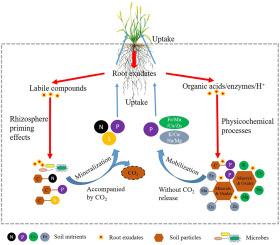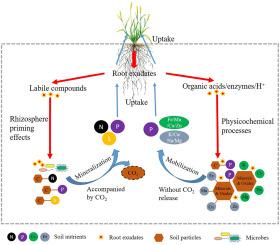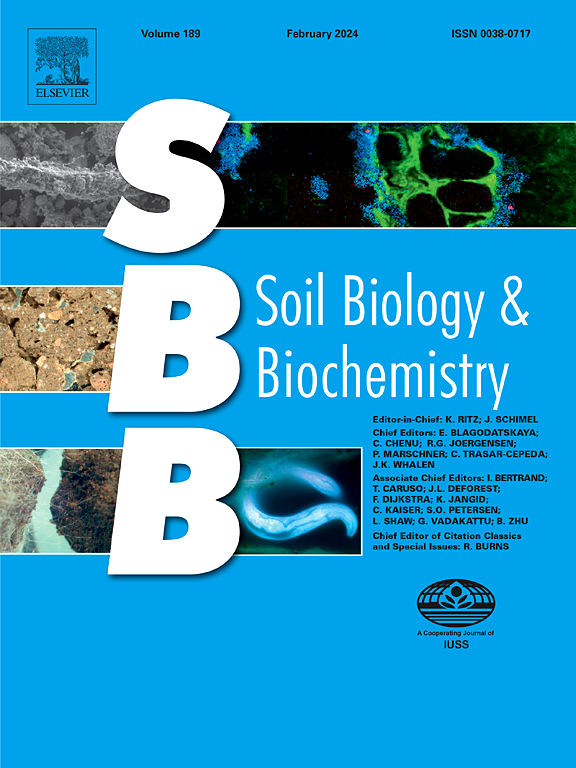Rhizosphere priming and effects on mobilization and immobilization of multiple soil nutrients
IF 10.3
1区 农林科学
Q1 SOIL SCIENCE
引用次数: 0
Abstract
Living roots and their rhizodeposition play a vital role in mediating soil organic carbon (SOC) decomposition and nutrient mobilization. It is virtually unknown how the rhizosphere effects on soil nutrient mobilization are connected with the rhizosphere priming on SOC decomposition. Here we investigated the rhizosphere effects of six grassland species (four grasses and two legumes) on soil nutrient mobilization and SOC decomposition with and without nitrogen (N) fertilization in a 95-day pot experiment. Plant nutrient acquisition, soil extractable nutrients, and net nutrient mobilization or immobilization were determined to evaluate the rhizosphere effect on soil nutrient dynamics. Primed SOC decomposition was measured as the difference in soil-derived CO2–C between planted and unplanted treatments. Without N fertilization, all species consistently increased net phosphorus (P), sodium (Na), iron (Fe), and copper (Cu) mobilization and most species increased net N, sulfur (S), calcium (Ca), and zinc (Zn) mobilization and net potassium (K), magnesium (Mg), and manganese (Mn) immobilization compared to the unplanted soil. These results suggest that grassland species could induce both positive and negative rhizosphere effects on soil nutrient mobilization with different magnitude. With N fertilization, plant-induced net N mobilization increased, while plant-induced net P and S mobilization decreased. Further, plant biomass, plant N, P, and S acquisition, and plant-induced net N, P, and S mobilization (i.e., net nutrient mobilization in excess of the unplanted control), were positively correlated with primed SOC decomposition across six species, indicating that the mobilization of organically bound nutrients (N, P, and S) was connected with the rhizosphere priming on SOC decomposition. In contrast, plant-induced net nutrient mobilization of base cations and micronutrients was not related to primed SOC decomposition. Overall, our results demonstrate that a substantial portion of nutrient availability stems from rhizosphere processes and is plant species-specific, and that nutrient release of N, P and S are closely connected with rhizosphere priming on SOC decomposition.


根瘤菌引导及其对多种土壤养分动员和固定的影响
活根及其根系沉积在介导土壤有机碳(SOC)分解和养分调动方面发挥着重要作用。根圈对土壤养分调动的影响与根圈对 SOC 分解的启动作用之间有何联系,目前几乎还不清楚。在此,我们在为期 95 天的盆栽实验中研究了六种草地物种(四种禾本科植物和两种豆科植物)在施氮肥和不施氮肥的情况下对土壤养分动员和 SOC 分解的根圈效应。通过测定植物养分获取量、土壤可提取养分以及净养分动员或固定情况,评估根圈对土壤养分动态的影响。以种植处理和未种植处理之间的土壤源 CO2-C 差值来衡量原始 SOC 分解情况。与未种植的土壤相比,在不施用氮肥的情况下,所有物种都持续增加了磷 (P)、钠 (Na)、铁 (Fe) 和铜 (Cu) 的净吸收量,大多数物种增加了氮、硫 (S)、钙 (Ca) 和锌 (Zn) 的净吸收量以及钾 (K)、镁 (Mg) 和锰 (Mn) 的净固定量。这些结果表明,草地物种可对土壤养分调动产生不同程度的正负根圈效应。施氮肥后,植物诱导的净氮动员增加,而植物诱导的净磷和净钾动员减少。此外,在六个物种中,植物生物量、植物氮、磷和硒的获取量以及植物诱导的氮、磷和硒净动员(即超过未种植对照的净养分动员)与SOC的初步分解呈正相关,表明有机结合养分(氮、磷和硒)的动员与根瘤菌层对SOC分解的初步作用有关。相比之下,植物诱导的基阳离子和微量营养元素的净养分动员与SOC的初步分解无关。总之,我们的研究结果表明,养分供应的很大一部分源于根瘤菌过程,并具有植物物种特异性,而且氮、磷和硒的养分释放与根瘤菌对 SOC 分解的促进作用密切相关。
本文章由计算机程序翻译,如有差异,请以英文原文为准。
求助全文
约1分钟内获得全文
求助全文
来源期刊

Soil Biology & Biochemistry
农林科学-土壤科学
CiteScore
16.90
自引率
9.30%
发文量
312
审稿时长
49 days
期刊介绍:
Soil Biology & Biochemistry publishes original research articles of international significance focusing on biological processes in soil and their applications to soil and environmental quality. Major topics include the ecology and biochemical processes of soil organisms, their effects on the environment, and interactions with plants. The journal also welcomes state-of-the-art reviews and discussions on contemporary research in soil biology and biochemistry.
 求助内容:
求助内容: 应助结果提醒方式:
应助结果提醒方式:


